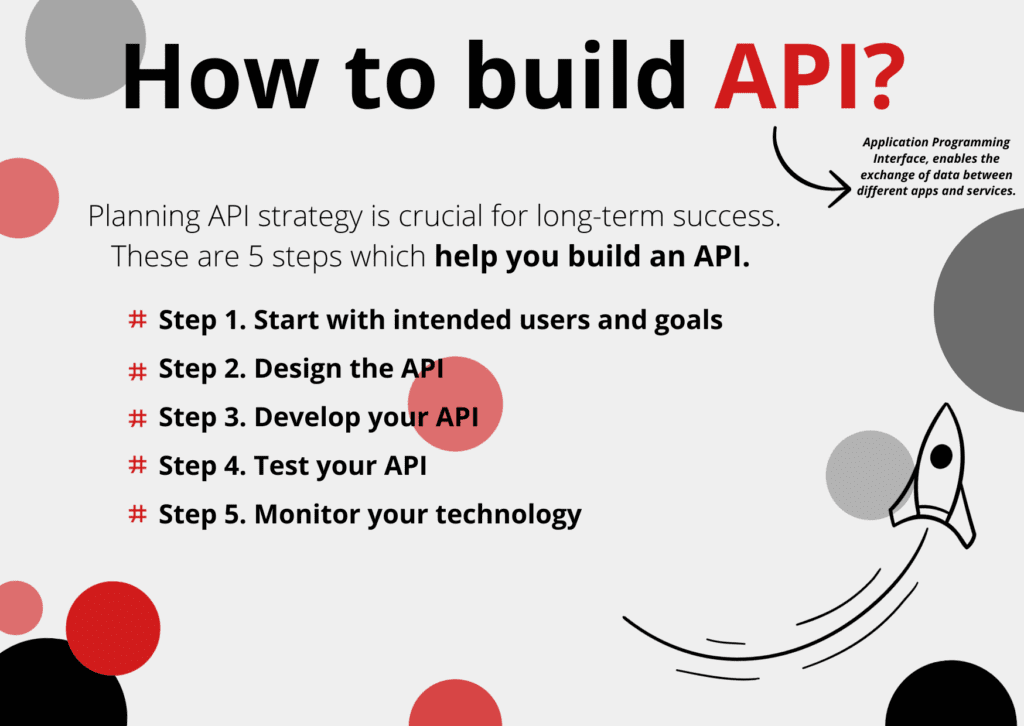Both your corporate network and personal devices host a variety of applications. Many of these applications need to communicate with one another to exchange data and enhance their functionality. This seamless interaction is made possible through APIs, which stands for Application Programming Interfaces.
If you’re interested in learning more about APIs and how to create them, please read this article.
What is API?
As mentioned earlier, an API, or Application Programming Interface, enables the exchange of data between different apps and services. It functions by allowing one app to request access to services from another app, facilitated by the right programming language. This technology greatly simplifies app development by providing the necessary tools for proper functioning.
Why is worth using API?
The primary advantage of an API is time-saving. Developers don’t need to understand the inner workings of the application programming interface, they simply utilize the interface as a communication channel between various applications or software programs.
Additional advantages of using this technology include:
- Streamlining processes: Accessing information about an application is possible from the same interface level.
- Enhanced precision and additional functionalities.
- Increased data security during transmission, especially through the implementation of tokens, electronic signatures, or TLS encryption.
Step 1. Start with intended users and goals
Planning API strategy is crucial for long-term success. The API should bring value not only for the intended users but also for your startup. To satisfy all needs, you’ll need more information about your target audience:
- Identify target developers and their needs.
- Adapt application programming interface to meet developer requirements.
- Enhance developer experience.
- Offer necessary tools.
Understanding the needs of users will help you define the requirements of application programming interface. There are two types of requirements, which you have to take into consideration. The first functional requirement will determine what technology can do, and the second one is non-functional and connected to things like security, performance and reliability.

Step 2. Design the API
Before you even write the first line of code, it’s essential to carefully consider the architecture that aligns with your requirements and caters to the needs of the developers who will be using the API. Your API should meet these five crucial non-functional requirements:
- Usability: Developers should be able to use this technology with minimal effort.
- Reliability: The API should have minimal downtime, ensuring consistent availability.
- Scalability: The system should effectively handle sudden load spikes without performance degradation.
- Security: Robust measures should be in place to protect the API from malicious users and threats.
- Testability: It should be easy for testers to identify and address any defects in the API.
Here are the steps to design an API that fulfills all these requirements:
Separate API design into levels
We recommend a technique for API design that involves breaking it down into three distinct levels, each responsible for a specific requirement. These levels sit between the clients and the API logic:
- Client: The front-end interface through which users interact with the API.
- Validation Level: This layer manages access to all app interactions, ensuring security and compliance.
- Caching Level: Responsible for sending caching instructions to clients, and optimizing data retrieval and response times.
- Orchestration Level: This level aggregates data from multiple sources, providing a unified and coherent view of information.
- Business Logic: The core layer that executes the API’s primary functions and processes data.
Pro Tip: It’s advisable to keep your API as lean as possible initially. You can always add functionality later, but removing features can be challenging!
Choose your architectural style
There are two of the most popular approaches to designing this technology: REST – Representational State Transfer and SOAP – Simple Object Access Protocol.
| Aspect | Simple Object Access Protocol (SOAP) | Representational State Transfer (REST) |
| Protocol Type | An official protocol with strict guidelines. | A flexible architectural style with loose guidelines. |
| Supported Protocols | Works with application layer protocols like HTTP, UDP, and SMTP. | Works only with HTTP. |
| Caching of Requests | Requests can’t be cached. | Requests can be cached. |
| API Contracts | Requires detailed API contracts. | No detailed contracts are needed. |
| Built-in Features (Security, Error Handling) | Has built-in security, error handling, and authorization. | Developers have to handle security, error handling, and auth. |
| Data Format | Uses verbose XML data format, consuming more bandwidth | Uses various data formats, including JSON, XML, HTML, and text. |
| Data Representation | Provides data as services (verbs + nouns). | Provides data as representations of resources (nouns only). |
| Benefits | Higher security and extensibility. | Higher performance, scalability, and flexibility. |
| Ideal Use Cases | Great for legacy and enterprise apps with high-security needs. | Great for web and mobile apps. |
Think about security
A poorly designed API can pose significant security vulnerabilities. Therefore, it’s crucial to prioritize security right from the design stage by considering these four essential security levels:
- Identification: Determine who is accessing your API.
- Authentication: Verify the identity of users to ensure they are who they claim to be.
- Authorization: Define and enforce restrictions on what actions users are allowed to perform within the application programming interface.
- Encryption: Implement measures to make data unintelligible to unauthorized users, safeguarding its confidentiality.

Step 3. Develop your API
After the designing process, it’s time to build your technology. Here is the list of steps which must be taken if you want to build API:
- Define API responses to standardize successful and error responses.
- Handle exceptions and errors, return appropriate HTTP status codes, and protect against data leaks.
- Create application programming interface endpoints with specified request types, responses, and errors. Test endpoints with Unit and Integration tests.
- Implement pagination and criteria-based searching for GET requests to manage large data responses.
- Analyze API performance using tools like Clinic.js and optimize accordingly for speed and efficiency.
- Consider client-side caching for performance improvement, and use Cache-Control headers for control.
- Write comprehensive application programming interface documentation covering authentication, endpoints, requests, responses, and more.
- Add versioning, especially for public APIs, to ensure backward compatibility and manage changes.
- Implement throttling mechanisms like traffic quotas, spike arrests, and concurrent rate limits to prevent disruptions from high traffic or attacks.
Step 4. Test your API
Testing the API is a crucial part of building it. Thanks to API visualization, you can start your test even before finishing all the code. Testing your work, remember some aspects
- Test API functions separately.
- Employ real data for authentic outcomes.
- Assess performance under diverse network conditions akin to real-world scenarios.
- Create simulations to mimic errors and unique situations through rapid response changes.
- Avoid using live APIs for performance testing.
Step 5. Monitor your technology
After completing testing and reviewing, the next step involves deploying your API to production. For enterprise-level APIs, hosting them on application programming interface gateways is common practice, ensuring top-notch security, performance, and scalability.
Once your API is live, monitoring its success metrics becomes essential. Depending on your objectives and the nature of your technology, you may want to track:
- API uptime,
- Monthly request volumes,
- Monthly unique users,
- Response times,
- Server CPU and memory usage,
- Time required for API key provisioning,
- Time to receive the first 200 OK responses,
- Time to onboard profitable applications,
- Monthly revenue (relevant for monetized APIs), and more.
Feel free to reach out if you have any questions about startups or outsourcing. Also, visit our social media and listen to our podcast, where we discuss startups!
